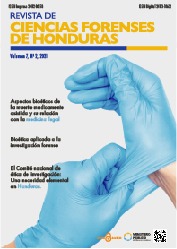Characterization of deceased identified and buried in a humanitarian cemetery. Considerations regarding the non-claim.
DOI:
https://doi.org/10.5377/rcfh.v7i2.13242Keywords:
Attitude towards death, Corpse, Forensic science, Human identification, Mortuary practices, Burial, MourningAbstract
Justification: The burial of unclaimed bodies by the immediate relatives or relatives of the judicial morgues is a continuous and periodic work assignment for the Forensic Science Centers not only in Honduras, but in Latin American countries. Objective: To know the sociodemographic characteristics of the deceased identified and unclaimed bodies that are buried in the humanitarian cemetery by the Forensic Medicine of Tegucigalpa and San Pedro Sula during the period of 2010-2020. Also, the probable relationship of the phenomenon of the loss of death rites with grief. Methodology: A descriptive and retrospective study of 235 cases of the people buried and identified was carried out and analyzed, 117 were from the city of Tegucigalpa and 118 from San Pedro Sula. Results: Honduran males made up to 97% of the deceased and of those 43.40% were from homicidal manner, 41.3% ranged from ages 21-45 years old, and 57% were from Tegucigalpa and San Pedro Sula, that predominantly, represent the identified corpses that no one claimed. Conclusion: The unclaimed of fully identified bodies is a process that needs to be studied more in depth and interdisciplinary manner to identify the factors that could influence such things as: fear of reprisals in deaths associated with criminal groups, affective dissociation between the deceased and it’s the family nucleus, migration, economic conditions,
likewise, citizen disinformation regarding institutional procedures; with the current information available is not possible to conclude what these factors are.
Downloads
455
PDF (Español (España)) 837
Published
How to Cite
Issue
Section
License
Copyright (c) 2022 Mariela Sánchez Zúniga

This work is licensed under a Creative Commons Attribution-NonCommercial 4.0 International License.
El autor conserva los derechos de autor bajo los terminos de una licencia CC NC 4.0





